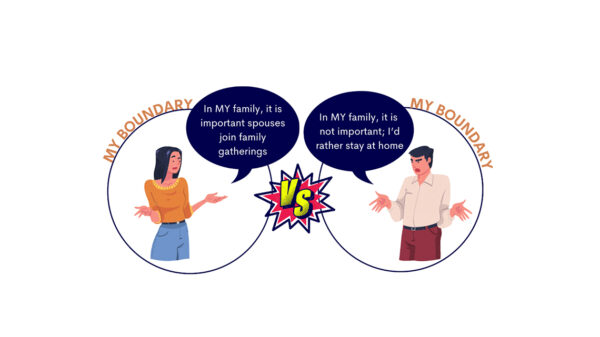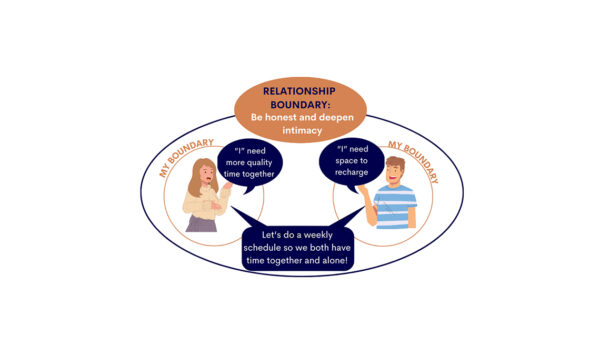What you will learn from this blog:
- How the conditioned belief of “boundaries are selfish” makes us resentful
- How to balance both partner’s boundaries and needs in a relationship by considering the “relationship boundary”
- How to communicate your boundaries in a conscious way
One reason why people ask – “are boundaries selfish?” – is because they are conditioned to believe asking for what you want is bad, and this will affect their relationships.
As therapists, these are some common concerns we hear at Intracresco:
“Every time I express my opinion it leads to a conflict, so I just keep quiet. How can I state my boundaries while maintaining harmony in my relationships?”
“People don’t like me because I speak my mind. I can’t seem to maintain relationships. I’ve learnt to be independent, but I can’t help feeling lonely. How can I be true to myself while finding a place to belong?”
The struggle to have both “me” and “us” is central to our search for a happy life. This blog explores 3 ways we can balance boundaries and relationships.
1. Change your mindset to believe it is possible to have both strong boundaries and healthy relationships
The subconscious belief in most people is that they have to choose: relationships vs individuality.
We often hear people say:
- “Don’t be so selfish; think about others.”
- “You have to make sacrifices when you start a family.”
- “Marriage is about compromise.”
Because we believe we have to choose between ourselves and others, we settle for either option.
We either:
- Suppress our individual needs to maintain relationships – or
- Neglect relationships and pursue our individual needs
Beliefs create reality. We need to start believing it is possible to build relationships where:
- Each individual’s unique views, feelings, and needs are respected and considered;
- There is a safe environment for each individual to speak their truth;
- There is a strong and stable sense of belonging, care, and “going through life together”;
- The stronger the “I”, the stronger the “we”, and vice versa.
2. Consider your “relationship boundary”
Boundaries are what define you – your values, beliefs, needs, feelings, aspirations, fears, past experiences and traumas. When two people initially come together in a relationship, they may unconsciously try to fit the other into their own boundary. This causes a “me” versus “you” situation.
In a relationship, it is important to recognise that there is a third boundary that is larger than both individual boundaries.

This is the boundary of the relationship – common values, beliefs, needs, and aspirations of both partners. And this can be achieved through emotional therapy.
A relationship thrives when partners equally consider all three boundaries:
(a) their own boundary,
(b) their partner’s boundary,
(c) the relationship’s boundary
In such a relationship, partners do not feel like they are sacrificing or compromising themselves for others. Rather, it is a matter of prioritising a higher need (e.g. connection) over a lower one (e.g. having it my way).
For example, two partners have different needs. They listen to and understand each other. They consider their shared relationship goal – to be honest with each other and deepen their bond. They know in love, they cannot have a fulfilling relationship if any partner’s needs are unmet. They find a solution to meet both needs and ultimately bring them closer.

3. Learn Conscious Communication
Many people feel stuck in relationships because they only see two options:
- Express my boundaries and get hurt because my partner fights back and does not listen
- Keep quiet and keep the peace, but feel resentful and grow distant from my partner
Conscious communication offers a third option. It involves:
- Expressing your feelings, needs, and boundaries from a space of awareness rather than emotion;
- Listening and empathising with the intention of understanding and connecting, rather than to see who is right or wrong
This creates a safe environment where boundaries can be expressed, understood, and addressed in a relationship. Through conscious communication, boundaries can bring partners closer, rather than apart.
Conclusion:
Setting boundaries addresses how to balance boundaries with relationships. This applies not just to romantic relationships, but to any relationship – family, friends, communities, etc.
This balance is not easy because there are very few examples of people who have
successfully created relationships where there is a balance of connection and
individuality.
– In many Eastern cultures, relationships and collectivism are emphasised, leading to many individuals suppressing their voices and feelings.
– In many Western cultures, individual freedom and rights are emphasised, leading to many feeling lonely and lost.
However, individuality and connection are non-negotiable needs for every human being. To live a truly fulfilling life, it is important to understand our own boundaries and how to express and address them harmoniously in relationships.
Reach out to us at Intracresco – we’re here to support you.
Learn more about setting healthy boundaries with emotional therapy with us.




